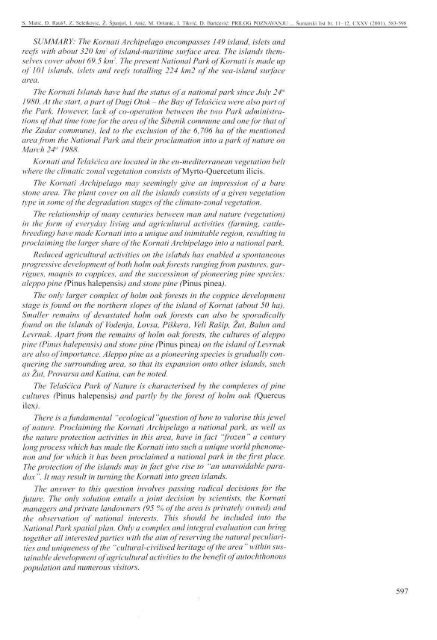Å UMARSKI LIST 11-12/2001 - HÅ D
Å UMARSKI LIST 11-12/2001 - HÅ D
Å UMARSKI LIST 11-12/2001 - HÅ D
Create successful ePaper yourself
Turn your PDF publications into a flip-book with our unique Google optimized e-Paper software.
S. Malić. Đ. Raušt, Z. Seletković, Ž. Spanjul, I. Anić. M. Oršanić, 1. Tikvić, D. Barićević: PRILOG POZNAVANJU ... Šumarski list br. <strong>11</strong>-<strong>12</strong>, CXXV (<strong>2001</strong>). 583-598<br />
SUMMARY: The Kornati Archipelago encompasses 149 island, islets and<br />
reefs with about 320 km 2 of island-maritime surface area. The islands themselves<br />
cover about 69.5 km 2 . The present National Park of Kornati is made up<br />
of 101 islands, islets and reefs totalling 224 km2 of the sea-island surface<br />
area.<br />
The Kornati Islands have had the status of a national park since July 24"'<br />
1980. At the start, a part of Dugi Otok - the Bay of Telašćica were also part of<br />
the Park. However, lack of co-operation between the two Park administrations<br />
of that time (one for the area of the Šibenik commune and one for that of<br />
the Zadar commune), led to the exclusion of the 6,706 ha of the mentioned<br />
area from the National Park and their proclamation into a park of nature on<br />
March 24 ,h 1988.<br />
Kornati and Telašćica are located in the eu-mediterranean vegetation belt<br />
where the climatic zoned vegetation consists o/'Myrto-Quercetum ilicis.<br />
The Kornati Archipelago may seemingly give an impression of a bare<br />
stone area. The plant cover on all the islands consists of a given vegetation<br />
type in some of the degradation stages of the climato-zonal vegetation.<br />
The relationship of many centuries between man and nature (vegetation)<br />
in the form of everyday living and agricultural activities (farming, cattlebreeding)<br />
have made Kornati into a unique and inimitable region, resulting in<br />
proclaiming the larger share of the Kornati Archipelago into a national park.<br />
Reduced agricultural activities on the islands has enabled a spontaneous<br />
progressive development of both holm oak forests ranging from pastures, garrigues,<br />
maquis to coppices, and the successinon of pioneering pine species:<br />
aleppo pine (Pinus halepensis) and stone pine (Pinus pinea/<br />
The only larger complex of holm oak forests in the coppice development<br />
stage is found on the northern slopes of the island of'Kornat (about 50 ha).<br />
Smaller remains of devastated holm oak forests can also be sporadically<br />
found on the islands of Vođenja, Lovsa, Piškera, Veli Rašip, Žut, Balun and<br />
Levrnak. Apartfrom the remains of holm oak forests, the cultures of aleppo<br />
pine (Pinus halepensis) and stone pine (Pinus pineaj on the island of Levrnak<br />
are also of importance. Aleppo pine as a pioneering species is gradually conquering<br />
the surrounding area, so that its expansion onto other islands, such<br />
as Zut, Provarsa and Katina, can be noted.<br />
The Telašćica Park of Nature is characterised by the complexes of pine<br />
cultures (Pinus halepensis) and partly by the forest of holm oak (Quercus<br />
ilex/<br />
There is a fundamental "ecological" question of how to valorise this jewel<br />
of nature. Proclaiming the Kornati Archipelago a national park, as well as<br />
the nature protection activities in this area, have in fact "frozen" a century<br />
long process which has made the Kornati into such a unique world phenomenon<br />
and for which it has been proclaimed a national park in the first place.<br />
The protection of the islands may in fact give rise to "an unavoidable paradox<br />
". It may result in turning the Kornati into green islands.<br />
The answer to this question involves passing radical decisions for the<br />
future. The only solution entails a joint decision by scientists, the Kornati<br />
managers and private landowners (95 % of the area is privately owned) and<br />
the observation of national interests. This should be included into the<br />
National Park spatial plan. Only a complex and integral evaluation can bring<br />
together all interested parties with the aim of reserving the natural peculiarities<br />
and uniqueness of the " cultural-civilised heritage of the area " within sustainable<br />
development of agricultural activities to the benefit of autochthonous<br />
population and numerous visitors.

















